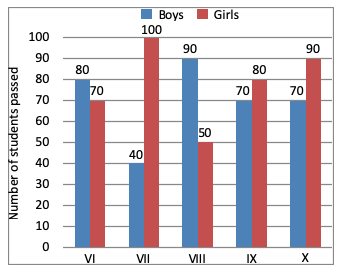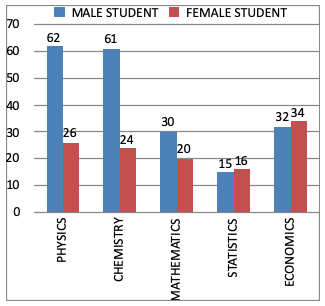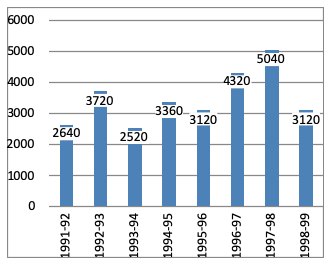Home > Practice > Data Interpretation > Bar Graphs > Miscellaneous
121. The bar graph shows the results of an annual examination in a secondary school in a certain year. Answer the following four questions based on this chart.

The class in which the number of boys passed is nearest to the average number of girls passed per class, is-
Class VI boys is nearest to the average no. of girls passed per class.

The class in which the number of boys passed is nearest to the average number of girls passed per class, is-
Solution:
Class VI boys is nearest to the average no. of girls passed per class.
122. The bar graph shows the results of an annual examination in a secondary school in a certain year. Answer the following four questions based on this chart.

The class having the highest number of passed students, is:
Class VII = 100 + 40 = 140
Class VIII = 90 + 50 = 140
Class IX = 80 + 70 = 150
Class X = 90 + 70 = 160 (highest)
Class X is highest number of students passed.

The class having the highest number of passed students, is:
Solution:
Class VI = 80 + 70 = 150Class VII = 100 + 40 = 140
Class VIII = 90 + 50 = 140
Class IX = 80 + 70 = 150
Class X = 90 + 70 = 160 (highest)
Class X is highest number of students passed.
123. The data given in bar diagram relate to the department wise admission of 320 students to B Sc. (Honors) first year classes of a certain college in the given five subjects. Study the graph and answer the questions.

The subject in which the difference in the number of male and female students is minimum in:

The subject in which the difference in the number of male and female students is minimum in:
Solution:
Statistics (1), It is clear from graph.
124. The data given in bar diagram relate to the department wise admission of 320 students to B Sc. (Honors) first year classes of a certain college in the given five subjects. Study the graph and answer the questions.

The total number of male students who got admitted in mathematics and economics as compared to the total number of female students getting admission in mathematics and economics is:
= 30 + 32
= 62
Total number of female students in Mathematics & Economics
= 20 + 34
= 54
∴ Required %

The total number of male students who got admitted in mathematics and economics as compared to the total number of female students getting admission in mathematics and economics is:
Solution:
Total number of male students in Mathematics and Economics= 30 + 32
= 62
Total number of female students in Mathematics & Economics
= 20 + 34
= 54
∴ Required %
125. The data given in bar diagram relate to the department wise admission of 320 students to B Sc. (Honors) first year classes of a certain college in the given five subjects. Study the graph and answer the questions.

The difference of the choice of the subject between male and female students is maximum for the subject.

The difference of the choice of the subject between male and female students is maximum for the subject.
Solution:
Chemistry (37), It is clear from graph.
126. The data given in bar diagram relate to the department wise admission of 320 students to B Sc. (Honors) first year classes of a certain college in the given five subjects. Study the graph and answer the questions.

The subject which the female student are finding difficult as compared to other subject is:
Maximum number of female students is difficulty in Statistics.

The subject which the female student are finding difficult as compared to other subject is:
Solution:
If is clear from graphMaximum number of female students is difficulty in Statistics.
127. The graph shows the exchange reserve of a country in difference years. Study the graph and answer the questions.

Ratio of the sum of exchange during the year 1991-92, 1992-93, 1993-94, to that during the years 1995-96, 1996-97 and 1997-98 is:
= 2640 + 3720 + 2520
= 8880
Reserve in year 1995-96, 1996-97 and 1997-98
= 3120 + 4320 + 5040
= 12480
∴ Required ratio
= 8880 : 12480
= 37 : 52

Ratio of the sum of exchange during the year 1991-92, 1992-93, 1993-94, to that during the years 1995-96, 1996-97 and 1997-98 is:
Solution:
Reserve in year 1991-92, 1992-93 and 1993-94= 2640 + 3720 + 2520
= 8880
Reserve in year 1995-96, 1996-97 and 1997-98
= 3120 + 4320 + 5040
= 12480
∴ Required ratio
= 8880 : 12480
= 37 : 52
128. The graph shows the exchange reserve of a country in difference years. Study the graph and answer the questions.

The exchange reserves in 1996 - 1997 were approximately what percent of the average exchange reserve over the period under review?

The exchange reserves in 1996 - 1997 were approximately what percent of the average exchange reserve over the period under review?
Solution:
129. The graph shows the exchange reserve of a country in difference years. Study the graph and answer the questions.

The percentage increase in the foreign exchange reserves in 1997 - 98 over 1993 - 94 is:

The percentage increase in the foreign exchange reserves in 1997 - 98 over 1993 - 94 is:
Solution:
130. The graph shows the exchange reserve of a country in difference years. Study the graph and answer the questions.

The ratio of number of years, in which the foreign exchange reserves are above the average reserves, to those in which the reserves are below the average reserves is:
Note :
Years in which the foreign exchange reserves are above the average reserves = 1992-93, 1996-97, 1997-98 = 3 years
Years in which the foreign exchange reserves are below the average reserves = 1991-92, 1993-94, 1994-95, 1995-1996, 1998-1999 = 5 years

The ratio of number of years, in which the foreign exchange reserves are above the average reserves, to those in which the reserves are below the average reserves is:
Solution:
Average reservesNote :
Years in which the foreign exchange reserves are above the average reserves = 1992-93, 1996-97, 1997-98 = 3 years
Years in which the foreign exchange reserves are below the average reserves = 1991-92, 1993-94, 1994-95, 1995-1996, 1998-1999 = 5 years